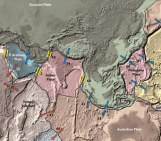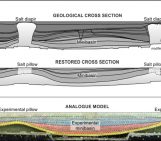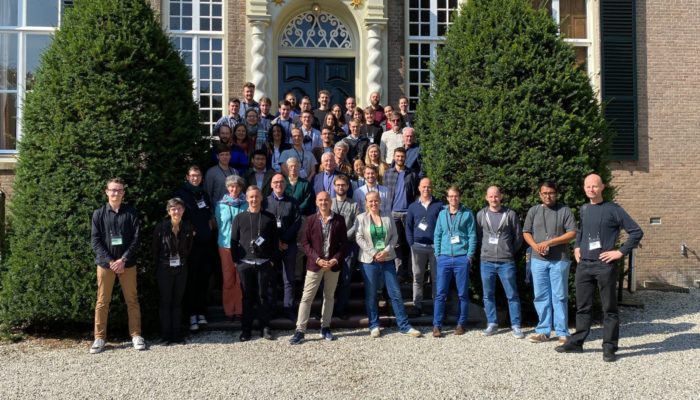
After a year and a half in which all of us have had to become accustomed to meeting our colleagues and collaborators only in digital space, it was finally time for an in-person conference again. From 19-23 of September 2021, the ninth edition of GeoMod took place in a conference center outside sunny Utrecht (the Netherlands). The organizing committee, led by Ernst Willingshofer, Ylona van Dinther, Liviu Matenco and Fred Beekman, decided to brave the relatively unchartered waters of organizing a hybrid event, after facing the postponement of the 2020 edition for over a year. A group of about sixty on-site participants was joined online by an equal number of researchers from all over the world. Despite the many (technical) challenges posed by hardware, connectivity and timezone differences that accompany such events, the participants were able to connect and share their work, ideas and even a cup of coffee due to the amazing integration of on-site and online space.
GeoMod is a biannual conference dedicated to bringing together numerical and analogue modelling work in the geosciences. Since the first edition in Milan in 2002, the event has been organised in cities all over Europe and fostered the growth of a community of scientist from a wide range of disciplines that share at the core of their work a single objective: using models to understand the complex processes driving the evolution of our planet and their expressions in the geological record. With session topics ranging from “Surface processes, landscapes, sediment fluxes and depositional systems” all the way to “Geodynamics and plate tectonics” and “Rheology and fluids”, the large spectrum of modelling techniques applied in geosciences was on display, and provided a great opportunity for participants to learn about the different challenges and limitations faced in numerical versus analogue modelling, and inspiration on how to face them.
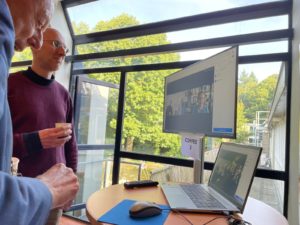
Participants interacting in one of the (virtual) coffee corners. Credit: the GeoMod organisers.
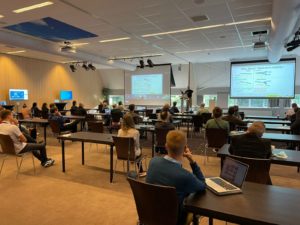
A keynote lecture on Monday morning by Maarten Kleinhans. Credit: the GeoMod organisers.
Keynote lectures provided by on-site and online participants managed to incite insightful discussions among the audience. The setup of coffee corners with large screens where online participants were able to connect directly with the speaker and each other made sure such discussions could carry on throughout the day. A main focus of the event were the 70 posters, which were organised fully hybrid with presenters and audience being connected through screens with live video connection. This filled the sessions with the familiar buzz of discussion as people strolled through the conference rooms and the online Hopin platform.
After a full scientific program followed by a good dinner, special evening lectures were provided on Monday and Tuesday night. The Dean of the faculty of Geosciences (Utrecht University), Wilco Hazeleger, talked about climate modelling and its national and global impact, and Jan Diederik van Wees (TNO) shared his knowledge on gas extraction and induced seismicity in the Netherlands. These lectures illustrated nicely how their work on modelling earth system processes directly impacts the Dutch and global societies.
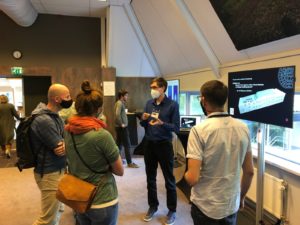
The hybrid poster sessions were an important focus of the conference. Credit: the GeoMod organisers.
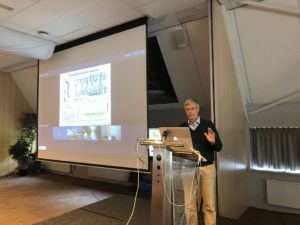
Jean-Philippe Avouac giving a keynote lecture on Tuesday afternoon. Credit: the GeoMod organisers.
The conference was closed with a visit to the Utrecht University Earth Simulation Laboratory, giving participants a taste of the state of the art work done in the lab. This ranged from experiments modelling earth surface processes in the Metronome Tidal Facility, all the way down to the deep subsurface experiments at the High Pressure and Temperature lab. The week left us all inspired and with renewed energy, looking forward to the next edition to be held in France in 2022.
Written by Hanneke Heida
Edited by Elenora van Rijsingen


